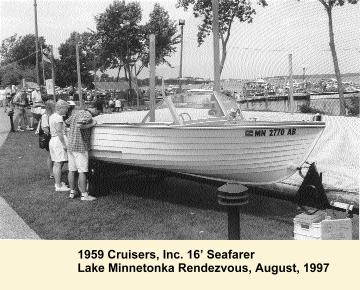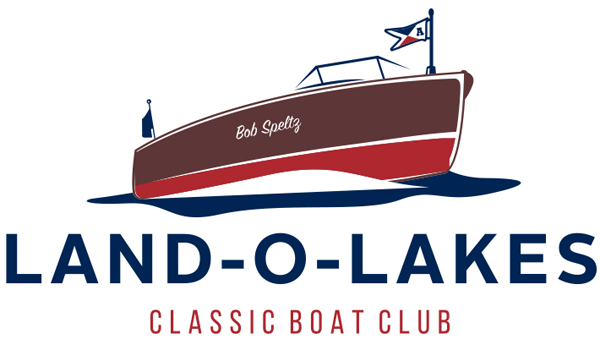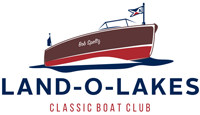by Andreas Jordahl Rhude
Thompson, Cruisers, Inc., T & T, Thompson Royal-Craft, Thompson Skis, Inc., and the Thompson Division of Chris-Craft (later the Corsair Division) are names familiar to boat enthusiasts. The Thompson family was prolific in their boat building and marine enterprises. The genesis can be traced to the first years of this century.
 It all began in 1904 when Peter Thompson, the oldest son of Chresten and Anna Thompson, along with his brother Christ built a wooden, anti-leak canoe for their own personal use. They used the barn at the family farm near the city of Peshtigo, Wisconsin as their factory. Farming was tough in the sandy soil of Northeastern Wisconsin, so the two men began building more canoes which they offered for sale. In 1904 a total of 15 were built with the sale price ranging from $14.00 to $22.00. Their first clinker style row boat, a thirteen footer, was sold for $27.00 to a Mr. Simmons of Kenosha, Wisconsin. A small boat workshop was built adjacent to the barn that year and they placed their first advertisement in an outdoor sporting magazine.
It all began in 1904 when Peter Thompson, the oldest son of Chresten and Anna Thompson, along with his brother Christ built a wooden, anti-leak canoe for their own personal use. They used the barn at the family farm near the city of Peshtigo, Wisconsin as their factory. Farming was tough in the sandy soil of Northeastern Wisconsin, so the two men began building more canoes which they offered for sale. In 1904 a total of 15 were built with the sale price ranging from $14.00 to $22.00. Their first clinker style row boat, a thirteen footer, was sold for $27.00 to a Mr. Simmons of Kenosha, Wisconsin. A small boat workshop was built adjacent to the barn that year and they placed their first advertisement in an outdoor sporting magazine.
Peter had gained boat building experience as a youngster, working as a laborer at the Racine Boat Company as early as 1889. Around 1901 he moved to Algonac, Michigan and began working for a man by the name of Chris Smith. Smith was a boat builder too, father of Chris-Craft!
 By 1912, business was booming and it was necessary for all six of the Thompson boys to help with building the canoes and small row boats. 450 vessels were made that year. Peter and Chris were joined by their brothers Edward, Richard, and the twins, Ted and Adolph (called Tom) as well as their sister Hannah. Hannah was the glue that bound the family and their new enterprise together. She would remain an integral part of the business until her death in 1958 and she never received the recognition due her. In that day and age, women were often overlooked for their contributions to family and society.
By 1912, business was booming and it was necessary for all six of the Thompson boys to help with building the canoes and small row boats. 450 vessels were made that year. Peter and Chris were joined by their brothers Edward, Richard, and the twins, Ted and Adolph (called Tom) as well as their sister Hannah. Hannah was the glue that bound the family and their new enterprise together. She would remain an integral part of the business until her death in 1958 and she never received the recognition due her. In that day and age, women were often overlooked for their contributions to family and society.
They incorporated in 1912 as Thompson Brothers Boat Mfg. Co., Inc. and moved into a new, modern manufacturing facility within the city limits of Peshtigo in 1913. They realized they needed more space than was available at the farm and they also desired to be on the railroad, which was the means used to ship the majority of their products at the time. The city of Marinette, seven miles from Peshtigo, was enticing the Thompsons to select their city as the site for the new factory. Peshtigo won out, and construction of the factory began in the summer of 1912. The 21,600 square foot factory opened in early February 1913.
The Peshtigo Times newspaper reported on 01 May 1913 that Thompson boats were in good demand and that the factory could barely keep up with filling orders. They were even receiving inquiries from foreign countries!
The company built canoes, row-boats, and for a time they made Lake Michigan fishing tugs. The latter line was discontinued in 1918. Sailboats were also produced by the Thompsons, including: snipes; seagulls; Olympics; cubs; comets; nationals; and redheads. Lengths ranged form 12 to 23 feet. A 23 foot Skimabout sail boat sold for $625.00 in 1932, which included rigging and sails. Hull construction was of compressed seam, cedar strip planking over white oak ribs and it had a spruce mast and boom.
Demand continued to grow and the Thompsons decided to built a branch factory at Cortland, New York in 1924. Edward, Tom, and Hannah were sent East to set up the new facility and Tom became its general manager. It was ready for operation just before the end of that year.
The Thompson Bros. 1929 catalogue listed that they had three factories: Peshtigo, Cortland, and Monrovia, California. The latter must have been a short lived operation, as no additional information is known about it. The same catalogue made the claim that Thompson was the worlds largest manufacturer of outboard motor boats.
During both World Wars, Thompson Bros. Boat switched gears and produced boats for the war efforts. They also made 15,000 paddles for the Army during WW II, and had several orders for 28 foot whale boats for the Navy as well as 16 foot wherries. In November 1944 Thompson received notice from the War Production Board that they could once again make pleasure boats.
 Six second generation Thompson boys also became involved with the businesses, whether by intent or just by happenstance. Ray, brothers Roy and Grant, brothers Ted, Jr. and Bob, and Glenn all worked at the Peshtigo plant, cutting their teeth in the business. Ted and Bob ended up in the Cortland, NY plant, and Roy and Grant ultimately took over ownership of Cruisers, Inc. Glenn was at Peshtigo, and after 1958 a co-owner of Thompson Boat Company of New York and president of Thompson Royal-Craft, Inc., also at Cortland. In 1960 he ventured out on his own and formed T & T Boats, Inc. of Wausaukee, Wisconsin. Ray ended up heading Thompson Bros. Boat at Peshtigo.
Six second generation Thompson boys also became involved with the businesses, whether by intent or just by happenstance. Ray, brothers Roy and Grant, brothers Ted, Jr. and Bob, and Glenn all worked at the Peshtigo plant, cutting their teeth in the business. Ted and Bob ended up in the Cortland, NY plant, and Roy and Grant ultimately took over ownership of Cruisers, Inc. Glenn was at Peshtigo, and after 1958 a co-owner of Thompson Boat Company of New York and president of Thompson Royal-Craft, Inc., also at Cortland. In 1960 he ventured out on his own and formed T & T Boats, Inc. of Wausaukee, Wisconsin. Ray ended up heading Thompson Bros. Boat at Peshtigo.
In the early summer of 1953 these second generation Thompsons decided they wanted to build larger cruising type boats, used for overnight camping trips. They established Cruisers, Inc. and were negotiating with officials at Menominee, Michigan and Oconto, Wisconsin to secure production facilities. They eventually selected Oconto and began revamping an existing building for boat production in September 1953. Ray Thompson was president and the other five cousins rounded out the ownership of the company. Their first completed boats were shipped out in November and consisted of four Seacoaster Specials and one Seacoaster Fisherman, all of 16 feet length and of lapstrake construction.
Cruisers, Inc. began under a cloud of trouble. The Thompson Boat laborers at Peshtigo had organized a union in early 1953 with leadership from an AFL official. A strike was called on 05 August 1953 and a settlement was not reached until 09 February 1954. For six months the Peshtigo plant was idle. Cruisers happened to start up just one month after the strike began and the first workers consisted of a number of striking Thompson employees. These included Alvin Tonn, Glenn Bud Grady, and Walter Wally Markham. Grady left Cruisers in 1959 to form Grady White Boats of Greenville, North Carolina and Markham later became president and owner of Carver Boats at Pulaski, Wisconsin. Tonn left Cruisers in 1960 and became superintendent of T & T Boats at Wausaukee and was superintendent of Grady White Boats from 1964 until 1968. For the first year or so, Cruisers, Inc. was making boats for Thompson Brothers which were sold under the Thompson brand name.
Boats of compressed seam, cedar strip hulls with white oak, steam bent ribs were produced at Thompson Bros. during the 1930s through the 1950s. In the early to mid fifties, the switch to lapstrake constructed hulls took place. This type of construction resulted in a more sturdy boat which was necessary with the more powerful and faster outboard engines. All cedar strip models were discontinued after the big fire which destroyed the main Peshtigo factory on 26 April 1955 (the fire also destroyed 500 boats that were ready for shipment). Lapstrake designs dominated the Thompson line from then on. During this period they built from 4,500 to 5,000 boats each season.
Edward Thompson was responsible for many of the boat designs for Thompson Brothers, Cruisers, Inc., and T & T Boats. He came up with Thompsons TVT hull design which was introduced in 1928. Edward also invented the improved cutting equipment used to make the plywood lapstrakes. He received several U.S. patents including one for the lapstrake cutting machinery. The full length spray rail was an innovation of Thompson Boat.
A long standing family dispute was resolved effective 02 January 1959. Control of the various Thompson enterprises was divided up amongst the families. Ray and his children became controllers of Thompson Bros. Boat at Peshtigo; Roy and Grant got control of Cruisers, Inc.; and Bob and Ted, Jr. along with their cousin Glenn obtained the Cortland operation. It was no longer affiliated with Thompson Bros. Boat and it became, in essence, a competitor. Roy and Grant also owned Thompson Skis, Inc., the water ski factory they established in the late 1940s. This break up occurred during a period when many businesses were consolidating their operations under a centrally controlled management.
It is ironic that Thompson Bros. Boat was one of the first of the old-line wooden boat builders to offer an all fiberglass model in 1955. They also offered, for the first time, to cover all strip models with fiberglass below the spray rails. Their efforts in the fiberglass area were half-hearted and did not succeed. They continued to believe that fiberglass could never replace a good wood boat and ignored consumer demand for low maintenance boats. By 1966 Thompson Bros. Boat at Peshtigo and Cruisers, Inc. at Oconto were in deep trouble.
In 1965 a new enterprise within the Peshtigo factory, Thompson Fiberglass Boat Company, produced one fiberglass model, a 17 foot outboard runabout called the GV-180, but it was too little too late. No fiberglass models were made the following year.
From an employment high of nearly two hundred workers at Peshtigo, they had a skeleton crew of about 18 men in the factory by the summer of 1966. On the eleventh of August, a transaction selling the company was finalized. Control of Thompson Bros. Boat Mfg. Co. was turned over to Saul Padek from owners Ray Thompson and his children Peter and Carol Rae. It was originally reported that the sale price was in excess of half a million dollars, however it was later learned that Padek obtained the company for a little more than $3,000! He did, however, assume responsibility for the companys debts. The new owner filed for Chapter 11 bankruptcy in September and made arrangements to repay creditors, which was completed with success Peter Thompson remained with the firm for a short period of time, eventually ending six decades of Thompson involvement with the company that bears their name.
Padek slowing turned the company around and began the gradual switch to all fiberglass boats. By 1970, the last wooden hulled Thompson boat rolled off the factory floor. A 66 year tradition of wooden boat building ended unceremoniously.
Cruisers, Inc. was also in a sales slump due to not getting into production of fiberglass boats. In 1965 they sold less than 800 boats compared to the years 1959 and 1960 when they sold over 3,000 each year. An opportunity to get into fiberglass production arose in mid-1965, when Cruisers took over control of the defunct T & T Boats factory at Wausaukee. It was immediately retooled to make fiberglass boats. The facility was made available to Cruisers at favorable terms, making it possible for them to begin the transition from wooden to fiberglass boats.
In January 1962 Bob and Ted, Jr. sold Thompson Boat Company of New York to Chris-Craft Corporation and it became their Corsair Division. The Thompson brand name was utilized for a number of years after the sale, however it was ultimately dropped. Bob and Ted continued to participate in operation of the Cortland plant for many years.
Short lived T & T Boats, Inc. made wooden lapstrake boats ranging in size from 14 to 22 feet. Beginning in 1960, they struggled from the start due to inadequate financing; cash flow problems plagued them from the start. Several poor management decisions also contributed to their downfall. T & Ts were, however, solidly built and of high quality. By 1965 they closed shop and the plant was taken over by Cruisers, Inc. A serialized article about T & T can be found in The Thompson Dockside newsletter, beginning in the April/April 1998 issue.
Saul Padek and his dedicated employees rebuilt Thompson Boat Company and by the late 1960s and early 1970s sales were steadily increasing. The company built a new, modern factory in 1971 and doubled its size just two years later. In 1974 Thompson purchased the manufacturing rights for Tom Sawyer Boats and Sidewinder Boats and began to manufacture their models at Peshtigo. Thirty models were being made, ranging in size from 14 to 24 feet. Sales were up and they built 2,500 boats in 1978. The recession of the late seventies hit all boat manufacturers and Thompson was no exception. Padek jumped ship in 1979, the company went into receivership in April 1980, and finally closed in the summer of 1980 after new owners failed to make a go of it.
The Wausaukee plant of Cruisers-Mirro Marine closed in early 1980 and output at their Oconto plant was considerably reduced. All indicative of the economic troubles in the leisure industry.
The name Thompson continues to be associated with pleasure boats. In 1980, the largest Thompson dealer, Anderson Marine of St. Charles, Michigan purchased the assets of the company, including the rights to the name, all inventory, and equipment. It was moved from Peshtigo and set up in Michigan by Anderson and production resumed.
Cruisers, Inc. was purchased by Mirro Aluminum Company in December 1971. Roy Thompson continued to head their Mirro Marine Division until retiring in 1979. The company experienced rough seas and went through three ownership changes after 1971. In the late 1990s they manufacture large yachts from 28 to 50 feet in length with prices upwards of $580,000. The company is thriving.
Many old, wooden Thompson, Cruisers, and T & T boats continue to skim over the waters of the world. Enthusiasm in these beauties has recently increased and a new group of folk interested in them has organized under the direction of Miles Kapper. A bi-monthly newsletter, The Thompson Dockside, keeps us informed of items interesting to Thompson fanatics. Their web site is www.thompsondockside.com.
Andreas, author of this article, grew up on Lake Michigan with a 14 foot canvas covered, Thompson row boat and a 1964, 17 foot T & T Breakers model (both still owned by his father). He learned to water ski on Thompson Skis. He owns two Thompsons which are in dire need of restoration: a 14 foot cedar strip TVT (probably from the late 1940s) and a 1958, 17 lapstrake outboard (maybe a Sea-Lancer). Both are sitting in a factory in Peshtigo, Wisconsin right next door to where they were manufactured. The 17 footer is now undergoing its rejuvenation!
Andreas Jordahl Rhude, Minneapolis, is Area Sales Representative for Sentinel Structures, Inc. of Peshtigo, Wisconsin. The firm manufactures structural glued laminated timber for buildings, bridges, highway sound barriers, and for wooden ship construction. The USS Constitution Old Ironsides has received numerous replacement timbers from Sentinel Structures. The company is successor to Unit Structures, Inc., half of which was owned by various members of the Thompson family from 1934 until 1962. Andreas became a member of the BSLOL Chapter in the fall of 1997.
A Chapter of the Antique & Classic Boat Society
©1999-2005 BSLOL ACBS Chapter

